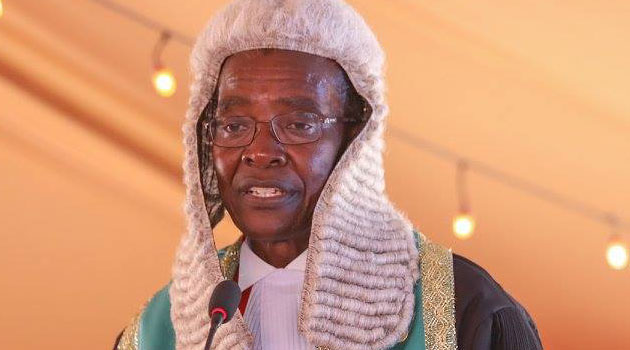
Already, selected courts are piloting electronic filing systems, online assessment of court fees and the rollout of speech to text software which will facilitate automatic transcription of proceedings/FILE
NAIROBI, Kenya, Jan 5 – The Judiciary is hoping to fast-track hearing cases this year – among them 66,214 suits that have been pending in courts for five years and above – through digitization and automation of court processes.
Already, selected courts are piloting electronic filing systems, online assessment of court fees and the rollout of speech to text software which will facilitate automatic transcription of proceedings.
To ease processing of court fees, the Judiciary targets 100 per cent transition to mobile money payment systems with 80 per cent of court stations reported to be using mobile money according to the State the Judiciary and the Administration of Justice Report (SOJAR) 2016-2017, released in December by Chief Justice David Maraga.
A rollout of the Judiciary Financial Management Information System (JFMIS) is also underway with the ultimate goal of enhancing accountability and transparency.
“The implementation of a far-reaching digital strategy that will not only transform the way our courts work but also how the public interacts with us,” Maraga pointed out at the time the report was being released.
“This will not only speed the hearing of cases but will also help us maintain the integrity of court records,” he added.
With 533,350 cases pending, Justice Maraga is keen to have the backlog cleared with the first priority being given to the over 60,000 cases that have remained unresolved for between 5-10 years.
According to Maraga, these cases – 66,214 in number – will be concluded by the end of 2018.
Judges and magistrates, however, face an uphill task of clearing the over half a million pending cases given the growing litigious tradition of Kenyans.
SOJAR 2016-2017, for instance, recorded that 344,180 of the pending cases were filed in the period under review alone.
Compared to 2015-2016, the number of pending matters increased by over 30,000, having been captured at 499,341 in 2015/16.
The numbers were however higher in 2014-2015 at 612,309.
Magistrate Courts account for the highest number of backlog which stands at 366,133 according to SOJAR 2016-2017.
The second highest number of pending cases, 119,777, lies at High Courts in Nairobi, Bungoma, Busia, Embu, Garissa, Homabay, Kakamega, Kericho, Kerugoya, Kisii, Kisumu, Machakos, Malindi, Meru, Mombasa, Muranga, Nakuru, Nyeri, Trans-Nzoia and Uasin Gishu.
The Environment and Land Courts, Employment and Labour Relations Courts, Courts of Appeal and the Supreme Court have 27,242, 13,723, 3,387 and 73 unconcluded cases respectively.
Cumulatively, Magistrate Courts and High Courts in Nairobi account for 92 per cent of pending cases at 69 and 23 per cent respectively.
To facilitate successful implementation of programmes aimed at improving the efficiency of courts, various teams have been formed to oversee the initiatives.
Teams formed include a special Project Team, Business Analysis Team, Software Development Team, and a Customer Support Team.
Among inefficiencies the Judiciary is grappling with are slow service, missing files, and corruption.
According to SOJAR 2016-2017, 31 per cent of complaints received by the Office of Judiciary Ombudsman touched on slow delivery of service.
Missing files was the second most recurring complaint accounting for 26 per cent of all grievances.
Poor service, delayed rulings/judgments, and corruption followed at seventeen, ten and eight per cent.
There are 158 judges, 421 magistrates, and 55 kadhis spread across the country according to SOJAR 2016-2017.
With the hiring of 28 judges only in the period under review, the Judiciary is seeking an expanded budget to cater for its ever-increasing development needs which include enlisting more judges and magistrates, modernization of old courts, and the establishment of new courts.
Plans are underway to establish a High Court in every county in conformity with Section 12 (1) of the High Court Organization and Administration Act with the current 39 High Courts covering only 38 of the 47 counties.
The Judiciary is also implementing an expansion programme that will see a Magistrate Court established in each of the 290 constituencies in the country.
At the moment, Kenya’s justice to population ratio is a judge for at least 304,000 citizens.
With the World Bank projecting the country’s population to have grown from 47.24 million in 2015 to 48.46 million in 2016, the magistrate to citizen ratio is 1:115,000.
Budgetary constraints have been identified by Justice Maraga as one of the major impediment to judiciary’s transformation with allocations from the exchequer remaining at an average of one per cent of the national budget.
In the last financial year, the allocation slipped to 0.99 per cent according to Justice Maraga, falling below the internationally-recommended Judiciary Budget of 2.5 per cent of the national budget.
The Judiciary however absorbed only 67 per cent of funds allocated to it. This was, however, an improvement from the previous year where only 54 per cent of funds were utilized.









































